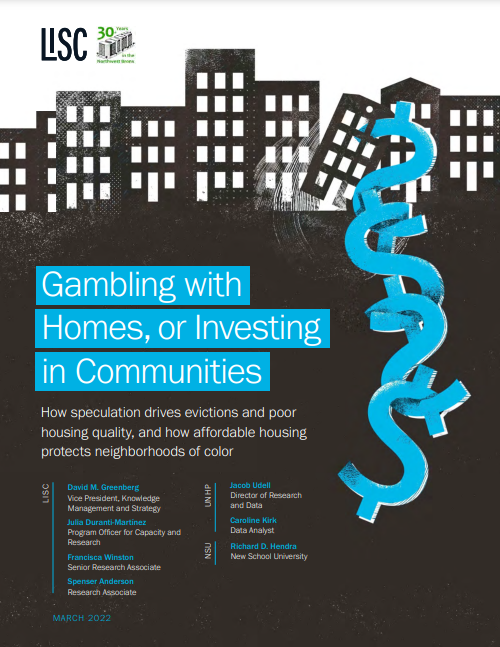Gambling with Homes, or Investing in Communities
LISC’s research report offers rigorous evidence that large landlords have reaped the greatest profits in communities of color, and that this speculation drives evictions and poor housing maintenance quality. But there’s good news too: affordable housing investments create better-maintained homes and remove buildings from the speculative market.
Executive Summary
Housing speculation has been broadly understood to be a major driver of displacement and hardship for Black, Indigenous, and People of Color (BIPOC) communities and individuals. Speculation in the multifamily housing market has also been defended as a way to spark investment in older buildings where lower-income people of color often live. This research examines that assumption, by asking about tenant outcomes in buildings with the fastestrising property values. In so doing, it is among the first to empirically analyze the association between apartment building finances and indicators of tenant stability and well-being. It builds on a groundbreaking set of databases created by the University Neighborhood Housing Program (UNHP), known as the BIP (Building Indicator Project), through which UNHP has been tracking and analyzing patterns of physical and financial distress in multifamily housing in New York City since 2008, and sales and debt events in the multifamily market since 2003.
Our goal is to understand patterns of speculation over time, and their impact on tenants in the form of housing maintenance quality and evictions. Because we combine these data with building-level information on affordable housing investments, we also explore how acquisition of distressed housing by nonprofits, tenant cooperatives, and other forms of affordable community stewardship may disrupt cycles of speculation and disinvestment and contribute to positive tenant outcomes. Understanding these patterns is particularly urgent given the ongoing impacts of COVID-19 on the housing market and low-income and BIPOC communities, including the looming eviction crisis and the threat of increased investor acquisitions of distressed multifamily buildings in communities still struggling to recover.
